
The Noctilucales are an order of marine dinoflagellates. They differ from most others in that the mature cell is diploid and its nucleus does not show a dinokaryotic organization. They show gametic meiosis.

Bioluminescence is the production and emission of light by living organisms. It is a form of chemiluminescence. Bioluminescence occurs widely in marine vertebrates and invertebrates, as well as in some fungi, microorganisms including some bioluminescent bacteria, and terrestrial arthropods such as fireflies. In some animals, the light is bacteriogenic, produced by symbiotic bacteria such as those from the genus Vibrio; in others, it is autogenic, produced by the animals themselves.

The haddock is a saltwater ray-finned fish from the family Gadidae, the true cods. It is the only species in the monotypic genus Melanogrammus. It is found in the North Atlantic Ocean and associated seas, where it is an important species for fisheries, especially in northern Europe, where it is marketed fresh, frozen and smoked; smoked varieties include the Finnan haddie and the Arbroath smokie. Other smoked versions include long boneless, the fileted side of larger haddock smoked in oak chips with the skin left on the fillet.

Siphonophorae is an order within Hydrozoa, which is a class of marine organisms within the phylum Cnidaria. According to the World Register of Marine Species, the order contains 175 species described thus far.
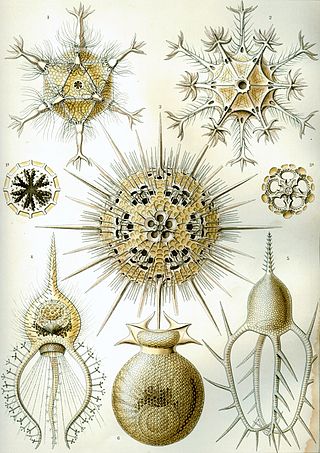
Phaeodarea or Phaeodaria is a group of amoeboid cercozoan organisms. They are traditionally considered radiolarians, but in molecular trees do not appear to be close relatives of the other groups, and are instead placed among the Cercozoa. They are distinguished by the structure of their central capsule and by the presence of a phaeodium, an aggregate of waste particles within the cell.

Milky seas, also called mareel, is a luminous phenomenon in the ocean in which large areas of seawater appear to glow translucently. Such occurrences glow brightly enough at night to be visible from satellites orbiting Earth.
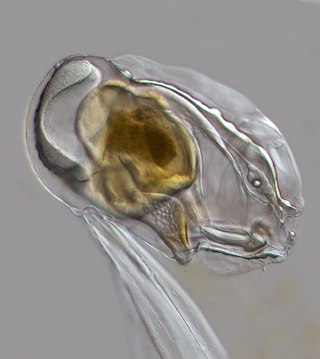
Oikopleura is a genus of tunicates in the class Appendicularia (larvaceans). It forms a mucus house every four hours at 20 degrees Celsius. This house has a coarse mesh to keep out big particles, and a fine mesh that collects the small particles, down to the nanoplankton that includes (pelagic) bacteria.
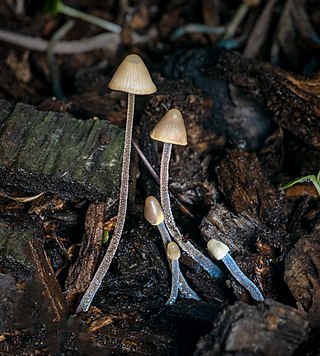
Mycena is a large genus of small saprotrophic mushrooms that are rarely more than a few centimeters in width. The name Mycena comes from the Ancient Greek μύκηςmykes, meaning "fungus". Species in the genus Mycena are commonly known as bonnets.

Coelenterazine is a luciferin, a molecule that emits light after reaction with oxygen, found in many aquatic organisms across eight phyla. It is the substrate of many luciferases such as Renilla reniformis luciferase (Rluc), Gaussia luciferase (Gluc), and photoproteins, including aequorin, and obelin. All these proteins catalyze the oxidation of this substance, a reaction catalogued EC 1.13.12.5.
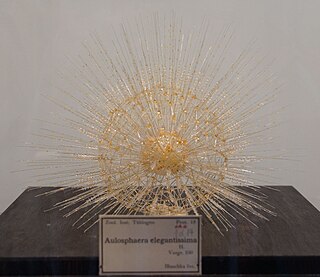
Aulosphaera is a genus of Cercozoa. The genus contains bioluminescent species. It one of two known bioluminescent phaeodarean genera, the other being Tuscaridium. The described bioluminescent species is Aulosphaera triodon Haeckel, 1887.
Swima bombiviridis is a worm species that lives in the deep ocean. It is also known as the green bomber worm or bombardier worm. This deep ocean pelagic (free-swimming) annelid has modified bioluminescent gills that can be cast off from an individual. These discarded gills somewhat resemble green "bombs" that remain illuminated for several seconds after they have been discarded. It is thought that this is a defensive mechanism rather than reproductive, as it is seen in both mature and juvenile individuals. This species was the first of its genus, Swima, to be discovered, and was the only one with a formal scientific name as of 2010. The genus name, Swima, is derived from the Latin, referring to the animal's ability to swim. The species name, bombiviridis, is derived from the Latin prefix bombus, meaning humming or buzzing, and the suffix viridis, which is Latin for the color green. Swima bombiviridis therefore translates to "swimming green bomber".
Swima is a genus of marine polychaete worms found in the ocean at depths between 1,800 and 3,700 meters. Even if they are agile swimmers, they are often seen hanging immobile in the water column as they are neutrally buoyant. This deep ocean pelagic (free-swimming) genus has modified bioluminescent gills that can be cast off from an individual. These discarded gills somewhat resemble green "bombs" that remain illuminated for several seconds after they have been discarded. It is thought that this is a defensive mechanism rather than reproductive, as it is seen in both mature and juvenile individuals. And because they are eyeless, communicating with light would be difficult. Swima worms are closely related to the recently discovered genus Teuthidodrilus, another pelagic cirratuliform of the bathyal zone.

Omphalotus olivascens, commonly known as the western jack-o'-lantern mushroom, is an orange to brown-colored gilled poisonous mushroom endemic to the California Floristic Province. It is sometimes mistaken for chanterelles.

Bathyphysa conifera, sometimes called the flying spaghetti monster, is a bathypelagic species of siphonophore in the family Rhizophysidae. It is found in the northern Atlantic Ocean and off the coast of Southwestern Africa and California.
Eukrohnia fowleri is a deep-sea marine arrow worm. It is the only known bioluminescent member of the genus Eukrohnia, and one of the two known species of bioluminescent arrow worms, the other being the distantly related Caecosagitta macrocephala. The bioluminescent organ of Eukrohnia fowleri is found along the center of its tail fin on both its dorsal and ventral side. It has a secreted bioluminescence that is thought to be coelenterazine based. While both species use luciferases in conjunction with coelenterazine for light emission, the luciferase of Eukrohnia fowleri is highly stable after 30 minutes while the luciferase of Caecosagitta macrocephala becomes inactive. So far, there is no other bioluminescent organism that uses hexagonal packing in order to hold bioluminescent materials/ E. fowleri evolved through the adaptation to hypoxic water and due to the recent oxygenation of water they have been experiencing bottleneck events. These events have been seen as one of the reasons that E. fowleri have such low biodiversity.
Emplectonema kandai is a marine ribbon worm, found in the Aomori Bay at a depth of 35–40 meters, and coiled up on Chelyosoma sea squirts. They are reddish orange in color. They have many eyes. They vary in length, from 53–115 cm, and are about 0.5-0.7 mm in diameter, when they are stretched. It is the only currently known bioluminescent member of the genus Emplectonema, and furthermore is currently the only known bioluminescent ribbon worm. E. kandai flash brilliantly in an internal (non-secreted) luminescence, but only on stimulation. The stimulus may be mechanical, chemical, thermal or electrical. The color of their luminescence is whitish-green.
Acanthephyra purpurea, sometimes called the fire-breathing shrimp and deep-sea shrimp, is a species of bioluminescent deep sea shrimp first described in 1881. The species is known for 'vomiting' bioluminescent fluid when distressed, although the fluid likely originates from the hepatopancreas and not the stomach.
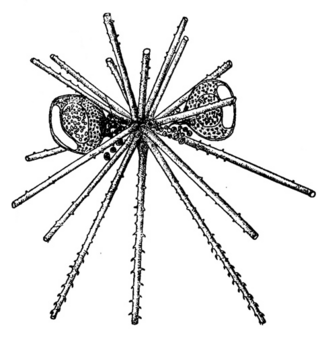
Astracantha is a genus of planktonic phaeodaria and the only member of the family Astracanthidae. They are an unusual family of marine protists, but can be found across all oceans, from tropical to Arctic and Antarctic waters.













